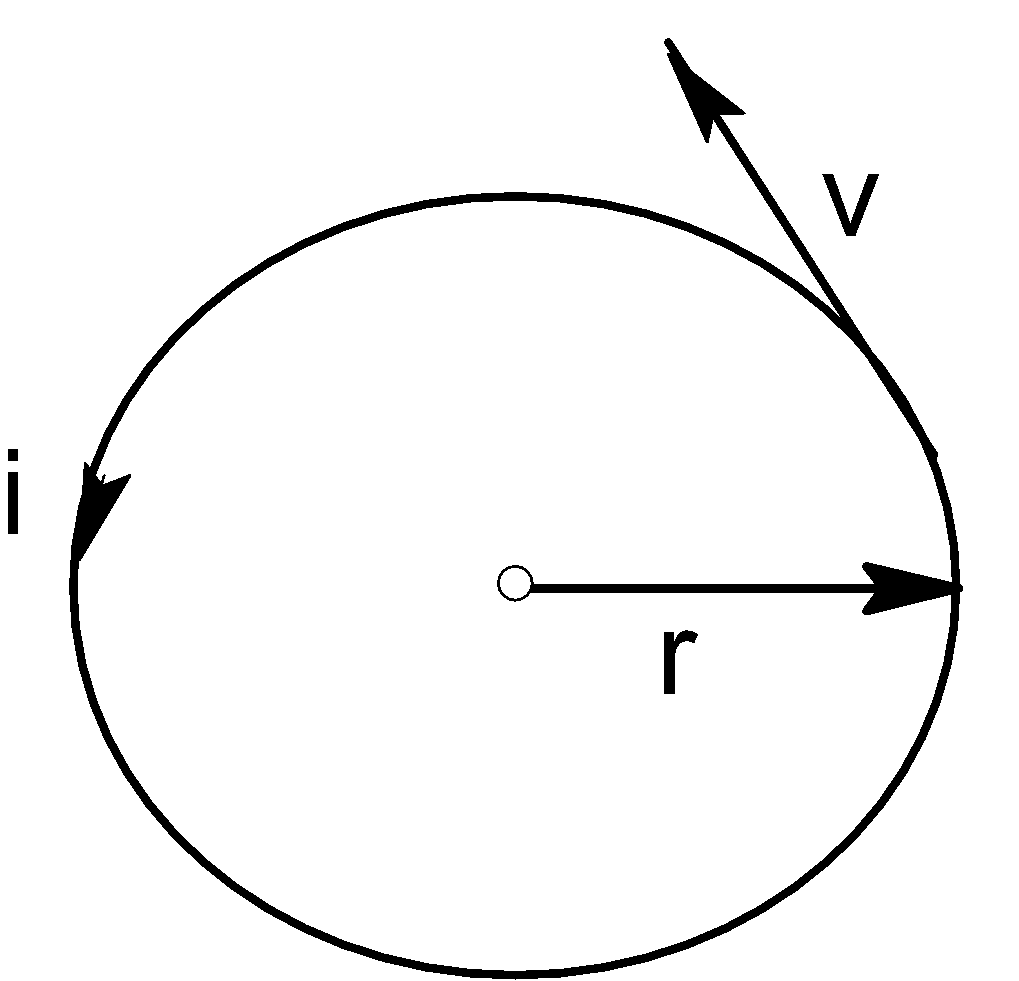
An electron moves in a circular orbit with uniform speed $v$.It produces a magnetic field $B$at the centre of the circle. The radius of the circle is proportional to
A.$\dfrac{B}{v}$
B.$\dfrac{v}{R}$
C.$\sqrt{\dfrac{v}{B}}$
D.$\sqrt{\dfrac{B}{v}}$
Answer
217.8k+ views
Hint: When an electron moves in a circular orbit with uniform speed producing a magnetic field at the centre of the circle. This is because a circular current is generated at the centre. Therefore by substituting the value of the equivalent current produced in a circular orbit in Biot-Savart law we can determine the radius of the circle.
Complete answer:
The electron moves in a circular orbit with uniform speed $v$and the magnetic field$B$ is produced at the centre of the circle. The time period of the electron that is moving in an angular orbit can be expressed as:
Time period,$T=\dfrac{2\pi r}{v}$ ……….(i)
Here $r$is the radius of the circle and $v$ the speed of the charged particle.
[since$2\pi r=$ Circumference of the circular path.]
Now the equivalent current,$i$ which is produced in a circle due to the flow of electrons is given by
$i=\dfrac{ch\arg e}{time}=\dfrac{e}{T}$ ………(ii)
Now putting the value $T$in equation (ii),
$i=\dfrac{e}{\dfrac{2\pi r}{v}}$
Or,$i=\dfrac{ev}{2\pi r}$ ……….(iii)
According to Biot-Savart law, the magnetic field $B$at a particular point induced by the flow of current can be expressed as,

$B=\dfrac{{{\mu }_{o}}i}{2r}$ ………(iv)
Here ${{\mu }_{o}}$denotes the permeability constant and $i$is equivalent current produced in a circular path.
Hence by substituting the value of the equivalent current,$i$in equation (iv) we get,
$B=\dfrac{{{\mu }_{o}}}{2r}\times \dfrac{ev}{2\pi r}$
Or,${{r}^{2}}=\dfrac{{{\mu }_{o}}ev}{4\pi B}$
Or,$r=\sqrt{\dfrac{{{\mu }_{o}}ev}{4\pi B}}$
Therefore $r$ $\alpha $ $\sqrt{\dfrac{v}{B}}$
The radius of the circle,$r$, is directly proportional to $\sqrt{\dfrac{v}{B}}$.
Thus, option (C) is correct.
Note: Magnetic permeability is used to determine materials resistance to a magnetic field. The higher the permeability, the higher will be the conductivity of magnetic lines of force. It is found that the materials like iron alloys, nickel alloys, and cobalt alloys have relatively high permeability.
Complete answer:
The electron moves in a circular orbit with uniform speed $v$and the magnetic field$B$ is produced at the centre of the circle. The time period of the electron that is moving in an angular orbit can be expressed as:
Time period,$T=\dfrac{2\pi r}{v}$ ……….(i)
Here $r$is the radius of the circle and $v$ the speed of the charged particle.
[since$2\pi r=$ Circumference of the circular path.]
Now the equivalent current,$i$ which is produced in a circle due to the flow of electrons is given by
$i=\dfrac{ch\arg e}{time}=\dfrac{e}{T}$ ………(ii)
Now putting the value $T$in equation (ii),
$i=\dfrac{e}{\dfrac{2\pi r}{v}}$
Or,$i=\dfrac{ev}{2\pi r}$ ……….(iii)
According to Biot-Savart law, the magnetic field $B$at a particular point induced by the flow of current can be expressed as,

$B=\dfrac{{{\mu }_{o}}i}{2r}$ ………(iv)
Here ${{\mu }_{o}}$denotes the permeability constant and $i$is equivalent current produced in a circular path.
Hence by substituting the value of the equivalent current,$i$in equation (iv) we get,
$B=\dfrac{{{\mu }_{o}}}{2r}\times \dfrac{ev}{2\pi r}$
Or,${{r}^{2}}=\dfrac{{{\mu }_{o}}ev}{4\pi B}$
Or,$r=\sqrt{\dfrac{{{\mu }_{o}}ev}{4\pi B}}$
Therefore $r$ $\alpha $ $\sqrt{\dfrac{v}{B}}$
The radius of the circle,$r$, is directly proportional to $\sqrt{\dfrac{v}{B}}$.
Thus, option (C) is correct.
Note: Magnetic permeability is used to determine materials resistance to a magnetic field. The higher the permeability, the higher will be the conductivity of magnetic lines of force. It is found that the materials like iron alloys, nickel alloys, and cobalt alloys have relatively high permeability.
Recently Updated Pages
Elastic Collision in Two Dimensions Explained Simply

Elastic Collisions in One Dimension Explained

Electric Field of Infinite Line Charge and Cylinders Explained

Electric Flux and Area Vector Explained Simply

Electric Field of a Charged Spherical Shell Explained

Electricity and Magnetism Explained: Key Concepts & Applications

Trending doubts
JEE Main 2026: Application Form Open, Exam Dates, Syllabus, Eligibility & Question Papers

Derivation of Equation of Trajectory Explained for Students

Hybridisation in Chemistry – Concept, Types & Applications

Understanding the Angle of Deviation in a Prism

Understanding Collisions: Types and Examples for Students

How to Convert a Galvanometer into an Ammeter or Voltmeter

Other Pages
JEE Advanced Marks vs Ranks 2025: Understanding Category-wise Qualifying Marks and Previous Year Cut-offs

Understanding Atomic Structure for Beginners

Ideal and Non-Ideal Solutions Explained for Class 12 Chemistry

Degree of Dissociation: Meaning, Formula, Calculation & Uses

Understanding Electromagnetic Waves and Their Importance

Understanding the Electric Field of a Uniformly Charged Ring




